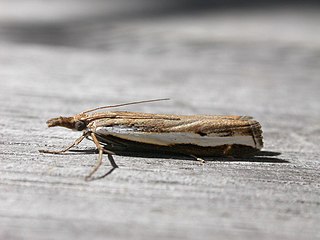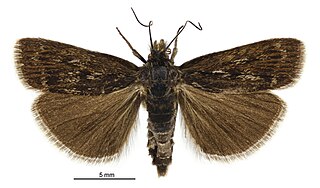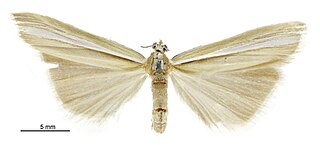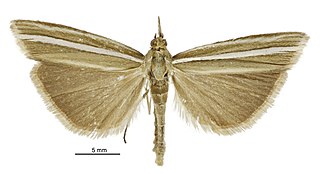
Orocrambus is a genus of moths of the family Crambidae. All species are endemic to New Zealand.

Scoparia caesia is a moth of the family Crambidae. It is endemic to New Zealand.

Orocrambus abditus is a moth in the family Crambidae. It was described by Alfred Philpott in 1924. It is endemic to New Zealand. O. abditus has been recorded in north Canterbury, Marlborough, and a small area around Birdling's Flat.

Orocrambus clarkei is a moth in the family Crambidae. It was described by Alfred Philpott in 1930. This species is endemic to New Zealand. It is known from Mount Moltke, Minaret Peak, Homer Saddle and the Humboldt Range.

Orocrambus cultus is a moth in the family Crambidae. It was first described by Alfred Philpott in 1917 from specimens collected by Merlin Owen Pasco. It is endemic to New Zealand, where it is known from Cecil Peak.

Orocrambus cyclopicus is a moth in the family Crambidae. It was described by Edward Meyrick in 1883. In 1975 David E. Gaskin wrongly synonymised Crambus sophistes with Orocrambus cyclopicus.

Orocrambus enchophorus is a moth in the family Crambidae. It was described by Edward Meyrick in 1885. It is endemic to New Zealand. It has been recorded from the South Island and North Island. The lives in lowland to alpine grassland habitat.

Orocrambus ephorus is a moth in the family Crambidae. It was described by Edward Meyrick in 1885. It is endemic to New Zealand. It has been recorded from the South Island. The species' preferred habitat consists of alpine tussock grasslands.

Orocrambus haplotomus is a moth in the family Crambidae. It was described by Edward Meyrick in 1883. This species is endemic to New Zealand. O. haplotomus has been recorded from the areas around Lake Te Anau and Lake Wakatipu in the South Island.

Orocrambus harpophorus is a moth in the family Crambidae. It was described by Edward Meyrick in 1882. It is endemic to New Zealand. The species has been recorded from the South Island and North Island.

Orocrambus heliotes is a moth in the family Crambidae. It was described by Edward Meyrick in 1888. This species is endemic to New Zealand. O. heliotes has been recorded in the South Island and the North Island. The habitat it prefers consists of swampy tussock grasslands and margins of slow-moving streams.

Orocrambus heteraulus is a moth in the family Crambidae. It was described by Edward Meyrick in 1905. It is endemic to New Zealand. This species has been recorded to inhabit the Humboldt Range and the Routeburn Valley.

Orocrambus horistes is a moth in the family Crambidae. It was described by Edward Meyrick in 1902. O. horistes is endemic to New Zealand, where it has only been recorded from the Chatham Islands.

Orocrambus lectus is a moth in the family Crambidae. It was described by Alfred Philpott in 1929. It is endemic to New Zealand, where it has been recorded from Fiordland and north-western Nelson. The habitat of this species consists of subalpine and alpine areas. Adults have been recorded from December to February. Adults of this moth are known to pollinate Olearia virgata.

Orocrambus melitastes is a moth in the family Crambidae. It was described by Edward Meyrick in 1909. This species is endemic to New Zealand, where it has been recorded in Southland, Otago and Westland. It is found from the subalpine zone down to sea level.

Orocrambus oppositus is a moth in the family Crambidae. It was described by Alfred Philpott in 1915. It is endemic to New Zealand, where it has been recorded in Fiordland. It is found in alpine grasslands.

Orocrambus ornatus is a moth in the family Crambidae. This species is endemic to New Zealand. It is classified as critically endangered by the Department of Conservation.

Orocrambus scutatus is a moth in the family Crambidae. It was described by Alfred Philpott in 1917. It is endemic to New Zealand, where it has been recorded in Southland. The habitat of this species consists of subalpine tussock grassland.

Orocrambus ventosus is a moth in the family Crambidae. It was described by Edward Meyrick in 1920. The species is endemic to New Zealand, where it has been recorded in the Tasman Mountains and at Mount Owen. Its preferred habitat is alpine grasslands.

Orocrambus xanthogrammus is a moth in the family Crambidae. It was described by Edward Meyrick in 1883. It is endemic to New Zealand, where it has been recorded from the South Island and the eastern part of the North Island. The habitat of this species consists of shingle river beds.





















